Paper Menu >>
Journal Menu >>
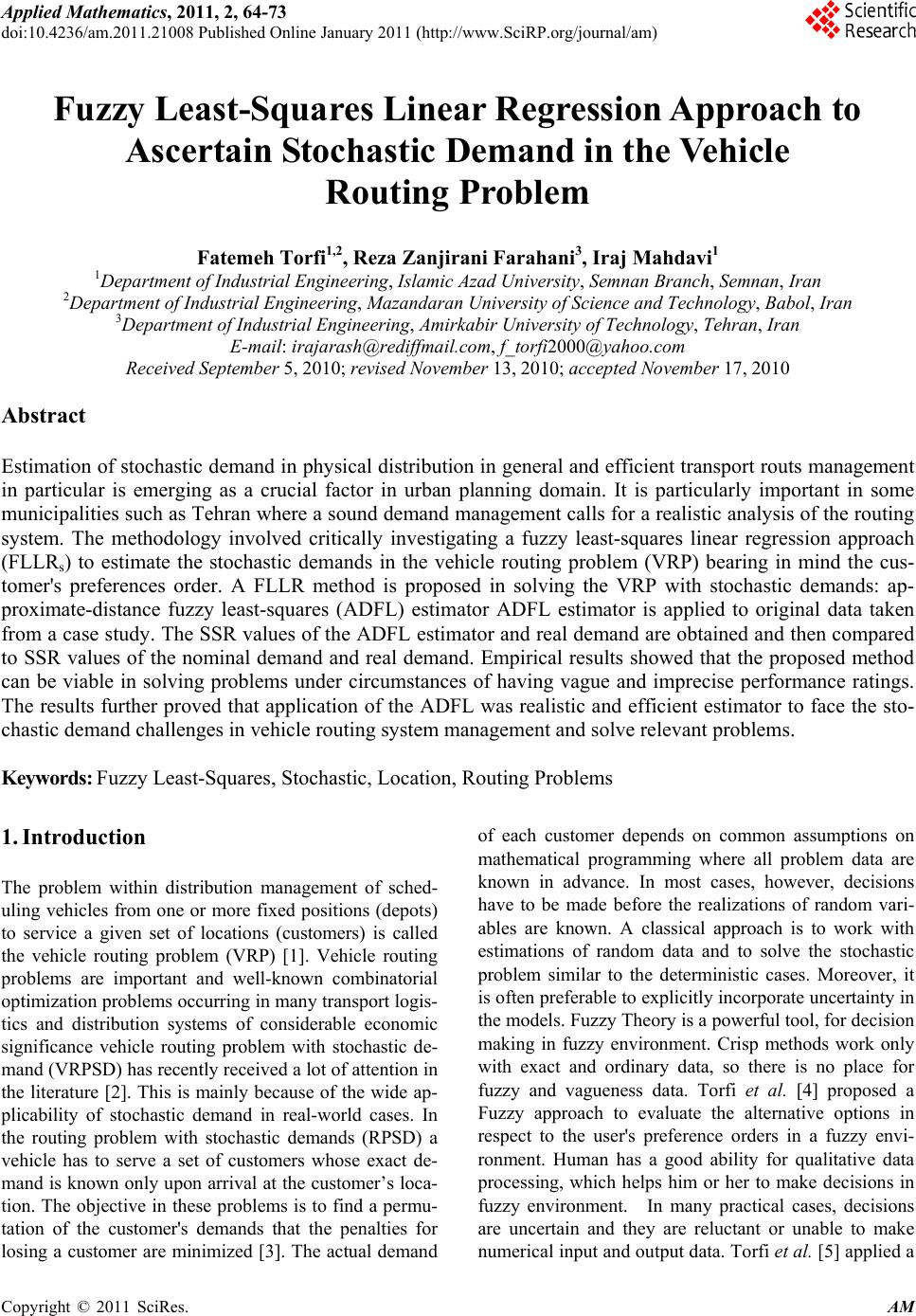 Applied Mathematics, 2011, 2, 64-73 doi:10.4236/am.2011.21008 Published Online January 2011 (http://www.SciRP.org/journal/am) Copyright © 2011 SciRes. AM Fuzzy Least-Squares Linear Regression Approach to Ascertain Stochastic Demand in the Vehicle Routing Problem Fatemeh Torfi1,2, Reza Zanjirani Farahani3, Iraj Mahdavi1 1Department of Industrial Engineering, Islamic Azad University, Semnan Branch, Semnan, Iran 2Department of Industrial Engineering, Mazandaran University of Science and Technology, Babol, Iran 3Department of Industrial Engineering, Amirkabir University of Technology, Tehran, Iran E-mail: irajarash@rediffmail.com, f_torfi2000@yahoo.com Received September 5, 2010; revised November 13, 2010; accepted November 17, 2010 Abstract Estimation of stochastic demand in physical distribution in general and efficient transport routs management in particular is emerging as a crucial factor in urban planning domain. It is particularly important in some municipalities such as Tehran where a sound demand management calls for a realistic analysis of the routing system. The methodology involved critically investigating a fuzzy least-squares linear regression approach (FLLRs) to estimate the stochastic demands in the vehicle routing problem (VRP) bearing in mind the cus- tomer's preferences order. A FLLR method is proposed in solving the VRP with stochastic demands: ap- proximate-distance fuzzy least-squares (ADFL) estimator ADFL estimator is applied to original data taken from a case study. The SSR values of the ADFL esti mator and real demand are obtained and then compared to SSR values of the nominal demand and real demand. Empirical results showed that the proposed method can be viable in solving problems under circumstances of having vague and imprecise performance ratings. The results further proved that application of the ADFL was realistic and efficient estimator to face the sto- chastic demand challenges in vehicle routing system management and solve relevant problems. Keywords: Fuzzy Least-Squares, Stochastic, Location, Routing Problems 1. Introduction The problem within distribution management of sched- uling vehicles from one or more fixed positions (depots) to service a given set of locations (customers) is called the vehicle routing problem (VRP) [1]. Vehicle routing problems are important and well-known combinatorial optimization problems occurring in many transport logis- tics and distribution systems of considerable economic significance vehicle routing problem with stochastic de- mand (VRPSD) has recently received a lot of attention in the literature [2]. This is mainly because of the wide ap- plicability of stochastic demand in real-world cases. In the routing problem with stochastic demands (RPSD) a vehicle has to serve a set of customers whose exact de- mand is known on ly upon arrival at the customer’s loca- tion. The objective in these problems is to find a permu- tation of the customer's demands that the penalties for losing a customer are minimized [3]. The actual demand of each customer depends on common assumptions on mathematical programming where all problem data are known in advance. In most cases, however, decisions have to be made before the realizations of random vari- ables are known. A classical approach is to work with estimations of random data and to solve the stochastic problem similar to the deterministic cases. Moreover, it is often preferable to explicitly incorpo rate uncertainty in the models. Fuzzy Theory is a powerful tool, for decision making in fuzzy environment. Crisp methods work only with exact and ordinary data, so there is no place for fuzzy and vagueness data. Torfi et al. [4] proposed a Fuzzy approach to evaluate the alternative options in respect to the user's preference orders in a fuzzy envi- ronment. Human has a good ability for qualitative data processing, which helps him or her to make decisions in fuzzy environment. In many practical cases, decisions are uncertain and they are reluctant or unable to make numerical input and output data. Torfi et al. [5] applied a 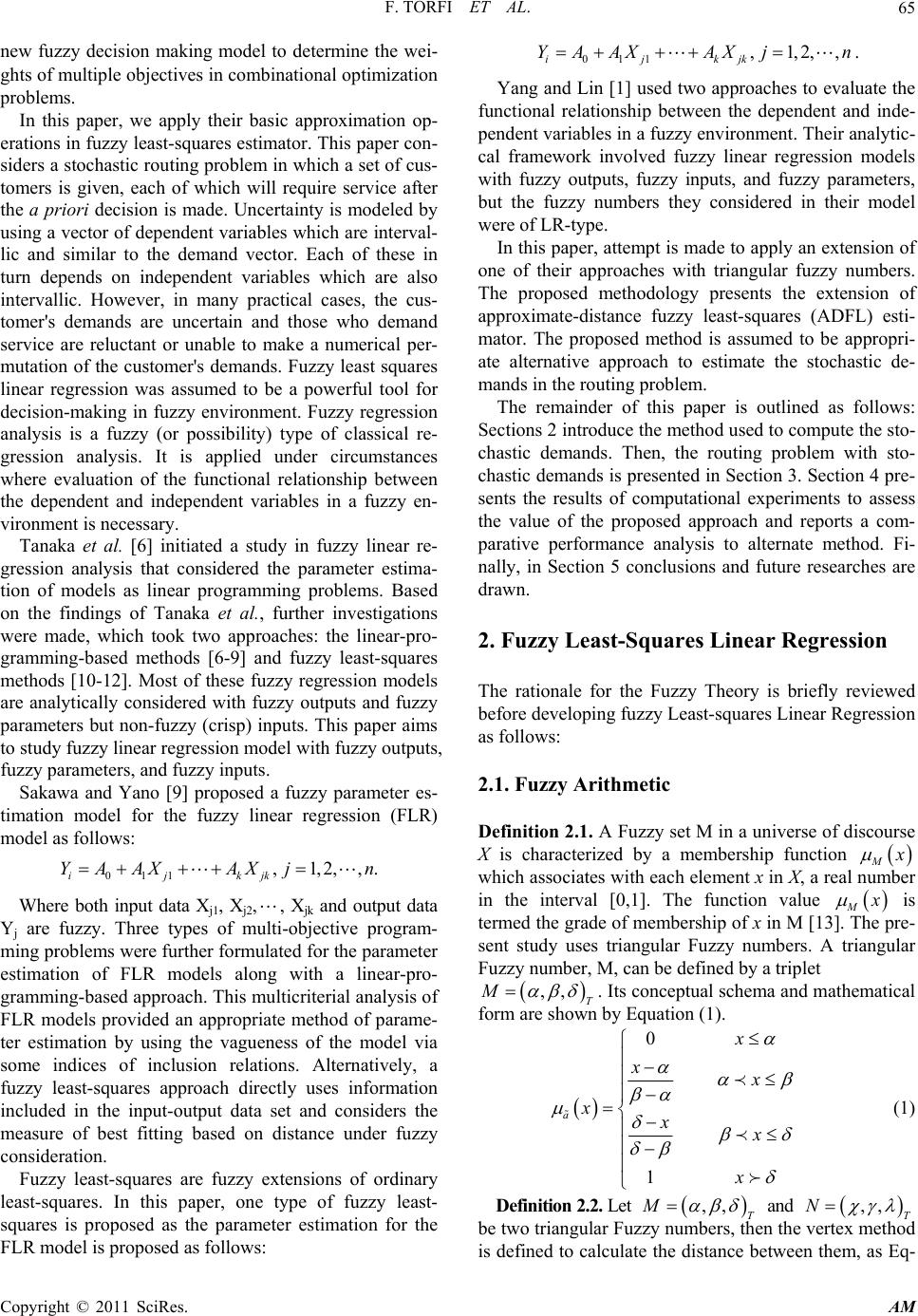 F. TORFI ET AL. Copyright © 2011 SciRes. AM 65 new fuzzy decision making model to determine the wei- ghts of multiple objectiv es in combinational op timization problems. In this paper, we apply their basic approximation op- erations in fuzzy least-squares estimator. This paper con- siders a stochastic routing problem in which a set of cus- tomers is given, each of which will require service after the a priori decision is made. Uncertainty is modeled by using a vector of dependent variables which are interval- lic and similar to the demand vector. Each of these in turn depends on independent variables which are also intervallic. However, in many practical cases, the cus- tomer's demands are uncertain and those who demand service are reluctant or unable to make a numerical per- mutation of the customer's demands. Fuzzy least squares linear regression was assumed to be a powerful tool for decision-making in fuzzy environment. Fuzzy regression analysis is a fuzzy (or possibility) type of classical re- gression analysis. It is applied under circumstances where evaluation of the functional relationship between the dependent and independent variables in a fuzzy en- vironment is necessary. Tanaka et al. [6] initiated a study in fuzzy linear re- gression analysis that considered the parameter estima- tion of models as linear programming problems. Based on the findings of Tanaka et al., further investigations were made, which took two approaches: the linear-pro- gramming-based methods [6-9] and fuzzy least-squares methods [10-12]. Most of these fuzzy regression models are analytically considered with fuzzy outputs and fuzzy parameters but non-fuzzy (crisp) inputs. This paper aims to study fuzzy linear regression model with fuzzy outputs, fuzzy parameters, and fuzzy i nputs. Sakawa and Yano [9] proposed a fuzzy parameter es- timation model for the fuzzy linear regression (FLR) model as follows: 011 , 1,2,,. ijkjk YAAX AXjn Where both input data Xj1, Xj2,, Xjk and output data Yj are fuzzy. Three types of multi-objective program- ming problems were further formulated for the parameter estimation of FLR models along with a linear-pro- gramming-based appro ach. This multicriterial analysis of FLR models provided an appropriate method of parame- ter estimation by using the vagueness of the model via some indices of inclusion relations. Alternatively, a fuzzy least-squares approach directly uses information included in the input-output data set and considers the measure of best fitting based on distance under fuzzy consideration. Fuzzy least-squares are fuzzy extensions of ordinary least-squares. In this paper, one type of fuzzy least- squares is proposed as the parameter estimation for the FLR model is proposed as follows: 011 , 1,2,, ijkjk YAAX AXjn . Yang and Lin [1] used two ap proaches to evaluate the functional relationship between the dependent and inde- pendent variables in a fuzzy environment. Their analytic- cal framework involved fuzzy linear regression models with fuzzy outputs, fuzzy inputs, and fuzzy parameters, but the fuzzy numbers they considered in their model were of LR-type. In this paper, attempt is made to app ly an extension of one of their approaches with triangular fuzzy numbers. The proposed methodology presents the extension of approximate-distance fuzzy least-squares (ADFL) esti- mator. The proposed method is assumed to be appropri- ate alternative approach to estimate the stochastic de- mands in the routing problem. The remainder of this paper is outlined as follows: Sections 2 introduce the method used to compute the sto- chastic demands. Then, the routing problem with sto- chastic demands is presented in Section 3. Section 4 pre- sents the results of computational experiments to assess the value of the proposed approach and reports a com- parative performance analysis to alternate method. Fi- nally, in Section 5 conclusions and future researches are drawn. 2. Fuzzy Least-Squares Linear Regression The rationale for the Fuzzy Theory is briefly reviewed before de ve loping fuz zy Least-squares Linear Regression as follows: 2.1. Fuzzy Arithmetic Definition 2.1. A Fuzzy set M in a universe of discourse X is characterized by a membership function M x which associates with each element x in X, a real number in the interval [0,1]. The function value M x is termed the grade of membership of x in M [13]. The pre- sent study uses triangular Fuzzy numbers. A triangular Fuzzy number, M, can be defined by a triplet ,, T M . Its conceptual schema and mathematical form are shown by Equation (1). 0 1 a x xx xxx x (1) Definition 2.2. Let ,, T M and ,, T N be two triangular Fuzzy numbers, then the vertex method is defined to calculate the distance between them, as Eq- 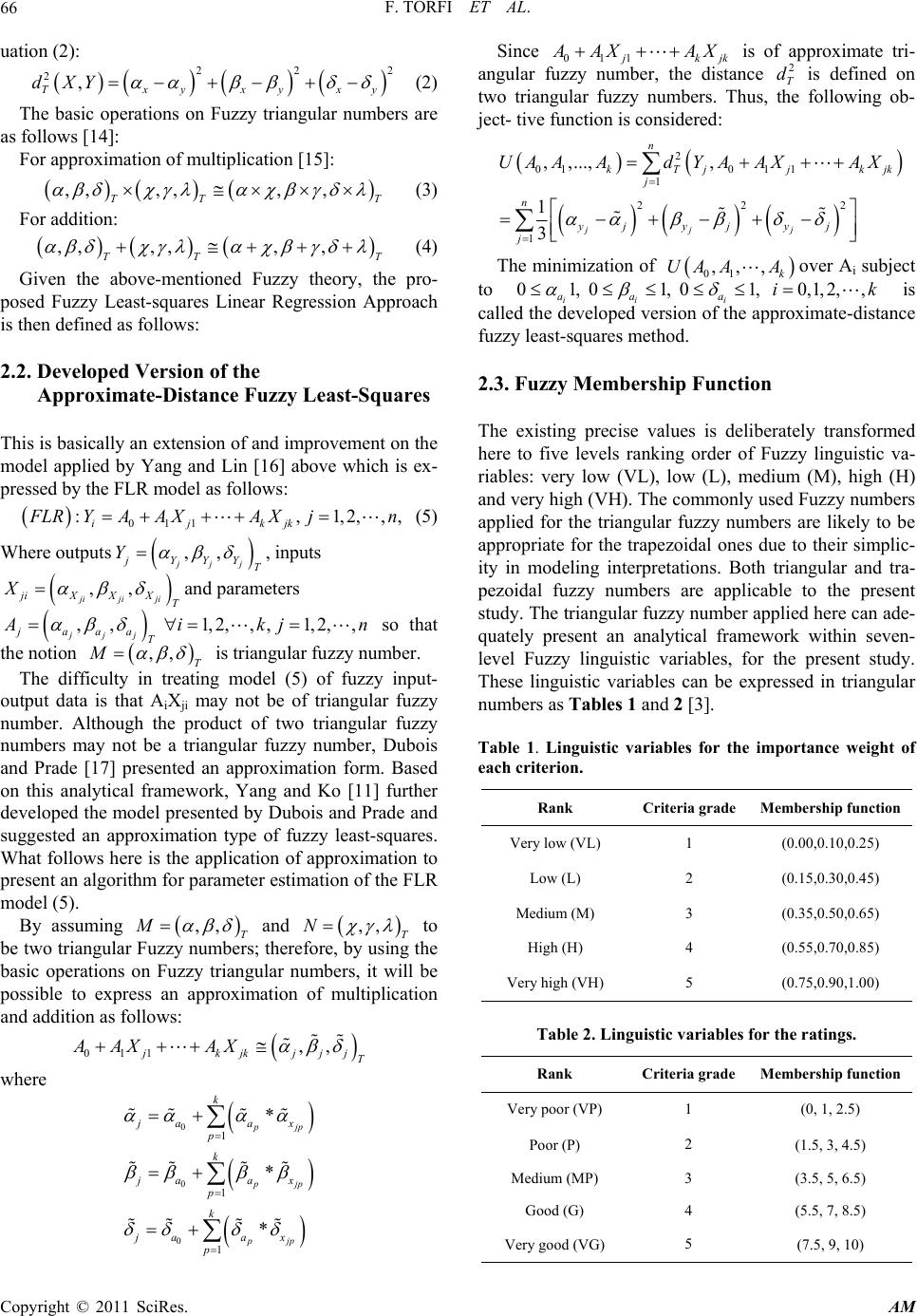 F. TORFI ET AL. Copyright © 2011 SciRes. AM 66 uation (2): 222 2, Txyxyxy dXY (2) The basic operations on Fuzzy triangular numbers are as follows [14]: For approximation of multiplication [15]: ,,,,, , TT T (3) For addition: ,,,,, , TT T (4) Given the above-mentioned Fuzzy theory, the pro- posed Fuzzy Least-squares Linear Regression Approach is then defined as follows: 2.2. Developed Version of the Approximate-Distance Fuzzy Least-Squares This is basically an extension of and improvement on the model applied by Yang and Lin [16] above which is ex- pressed by the FLR model as follows: 011 :, 1,2,,, ijkjk F LRYAAXAXjn (5) Where outputs ,, , jjj jYYY T Y inputs ,, jiji ji jiXXX T X and parameters ,, jjj jaaa T A 1,2,,, 1,2,,ikjn so that the notion ,, T M is tria ng ul ar f uzzy number. The difficulty in treating model (5) of fuzzy input- output data is that AiXji may not be of triangular fuzzy number. Although the product of two triangular fuzzy numbers may not be a triangular fuzzy number, Dubois and Prade [17] presented an approximation form. Based on this analytical framework, Yang and Ko [11] further developed the model presented by Dubois and Prade and suggested an approximation type of fuzzy least-squares. What follows here is the application of approximation to present an algorithm for parameter estimatio n of the FLR model (5). By assuming ,, T M and ,, T N to be two triangular Fuzzy numbers; therefore, by using the basic operations on Fuzzy triangular numbers, it will be possible to express an approximation of multiplication and addition as follows: 011 ,, jkjkjjj T AAX AX where 0 0 0 1 1 1 * * * pjp pjp pjp k ja ax p k ja ax p k ja ax p Since 011 j kjk A AX AX is of approximate tri- angular fuzzy number, the distance 2 T d is defined on two triangular fuzzy numbers. Thus, the following ob- ject- tive function is considered: 2 010 11 1 222 1 , ,...,, 1 3jjj n kTjjkjk j n yjyj yj j UAAAdYAAXAX The minimization of 01 ,, , k UAA Aover Ai subject to 01, 01, 01, 0,1,2,, ii i aa a ik is called the developed version of the approximate-distance fuzzy least-squares method. 2.3. Fuzzy Membership Function The existing precise values is deliberately transformed here to five levels ranking order of Fuzzy linguistic va- riables: very low (VL), low (L), medium (M), high (H) and very high (VH). The commonly used Fuzzy numbers applied for the triangular fuzzy numbers are likely to be appropriate for the trapezoidal ones due to their simplic- ity in modeling interpretations. Both triangular and tra- pezoidal fuzzy numbers are applicable to the present study. The triangular fuzzy number applied here can ade- quately present an analytical framework within seven- level Fuzzy linguistic variables, for the present study. These linguistic variables can be expressed in triangular numbers as Tables 1 and 2 [3]. Table 1. Linguistic variables for the importance weight of each criterion. Membership functionCriteria grade Rank (0.00,0.10,0.25) 1 Very low (VL) (0.15,0.30,0.45) 2 Low (L) (0.35,0.50,0.65) 3 Medium (M) (0.55,0.70,0.85) 4 High (H) (0.75,0.90,1.00) 5 Very high (VH) Table 2. Linguistic variables for the ratings. Membership functionCriteria grade Rank (0, 1, 2.5) 1 Very poor (VP) (1.5, 3, 4.5) 2 Poor (P) (3.5, 5, 6.5) 3 Medium (MP) (5.5, 7, 8.5) 4 Good (G) (7.5, 9, 10) 5 Very good (VG) 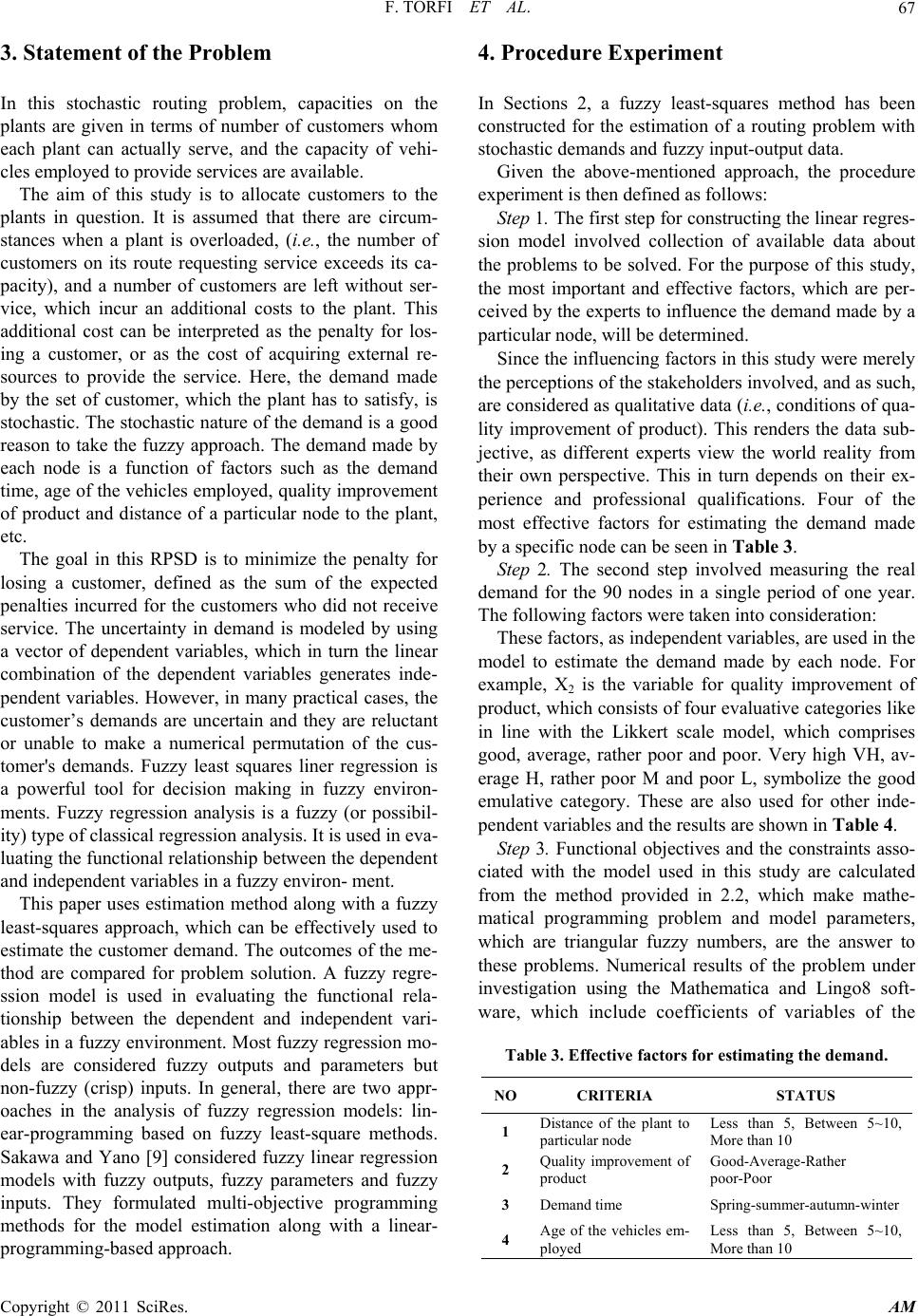 F. TORFI ET AL. Copyright © 2011 SciRes. AM 67 3. Statement of the Problem In this stochastic routing problem, capacities on the plants are given in terms of number of customers whom each plant can actually serve, and the capacity of vehi- cles employed to provide services are available. The aim of this study is to allocate customers to the plants in question. It is assumed that there are circum- stances when a plant is overloaded, (i.e., the number of customers on its route requesting service exceeds its ca- pacity), and a number of customers are left without ser- vice, which incur an additional costs to the plant. This additional cost can be interpreted as the penalty for los- ing a customer, or as the cost of acquiring external re- sources to provide the service. Here, the demand made by the set of customer, which the plant has to satisfy, is stochastic. The sto chastic nature of the demand is a good reason to take the fuzzy approach. The demand made by each node is a function of factors such as the demand time, age of the vehicles employed, quality improvement of product and distance of a particular node to the plant, etc. The goal in this RPSD is to minimize the penalty for losing a customer, defined as the sum of the expected penalties incurred for the customers who did not receive service. The uncertainty in demand is modeled by using a vector of dependent variables, which in turn the linear combination of the dependent variables generates inde- pendent variables. However, in many practical cases, the customer’s demands are uncertain and they are reluctant or unable to make a numerical permutation of the cus- tomer's demands. Fuzzy least squares liner regression is a powerful tool for decision making in fuzzy environ- ments. Fuzzy regression analysis is a fuzzy (or possibil- ity) type of classical regression analysis. It is used in eva- luating the function al relationship between the dependent and independent variables in a fuzzy environ- ment. This paper uses estimation method along with a fuzzy least-squares approach, which can be effectively used to estimate the customer demand. The outcomes of the me- thod are compared for problem solution. A fuzzy regre- ssion model is used in evaluating the functional rela- tionship between the dependent and independent vari- ables in a fuzzy environment. Most fuzzy regression mo- dels are considered fuzzy outputs and parameters but non-fuzzy (crisp) inputs. In general, there are two appr- oaches in the analysis of fuzzy regression models: lin- ear-programming based on fuzzy least-square methods. Sakawa and Yano [9] considered fuzzy linear regression models with fuzzy outputs, fuzzy parameters and fuzzy inputs. They formulated multi-objective programming methods for the model estimation along with a linear- programming-based approach. 4. Procedure Experiment In Sections 2, a fuzzy least-squares method has been constructed for the estimation of a routing problem with stochastic demands and fuzzy input-output data. Given the above-mentioned approach, the procedure experiment is then defined as follows: Step 1. The first step for constructing the linear regres- sion model involved collection of available data about the problems to be solved. For the purpose of this study, the most important and effective factors, which are per- ceived by the experts to influence the demand made by a particular node, will be determined. Since the influencing factors in this study were merely the perceptions of the stakeholders involved, and as such, are considered as qualitative data (i.e., cond itions of qua- lity improvement of product). This renders the data sub- jective, as different experts view the world reality from their own perspective. This in turn depends on their ex- perience and professional qualifications. Four of the most effective factors for estimating the demand made by a specific node can be seen in Table 3. Step 2. The second step involved measuring the real demand for the 90 nodes in a single period of one year. The following factors were taken into consideration: These factors, as independent variables, are used in the model to estimate the demand made by each node. For example, X2 is the variable for quality improvement of product, which con sists of four evaluative categories like in line with the Likkert scale model, which comprises good, average, rather poor and poor. Very high VH, av- erage H, rather poor M and poor L, symbolize the good emulative category. These are also used for other inde- pendent variables and the results are shown in Table 4. Step 3. Functional objectives and the constraints asso- ciated with the model used in this study are calculated from the method provided in 2.2, which make mathe- matical programming problem and model parameters, which are triangular fuzzy numbers, are the answer to these problems. Numerical results of the problem under investigation using the Mathematica and Lingo8 soft- ware, which include coefficients of variables of the Table 3. Effective factors for estimating the demand. STATUS CRITERIA NO Less than 5, Between 5~10, More than 10 Distance of the plant to particular node 1 Good-Average-Rather poor-Poor Quality improvement of product 2 Spring-summer-autumn-winter Demand time 3 Less than 5, Between 5~10, More than 10 Age of the vehicles em- ployed 4 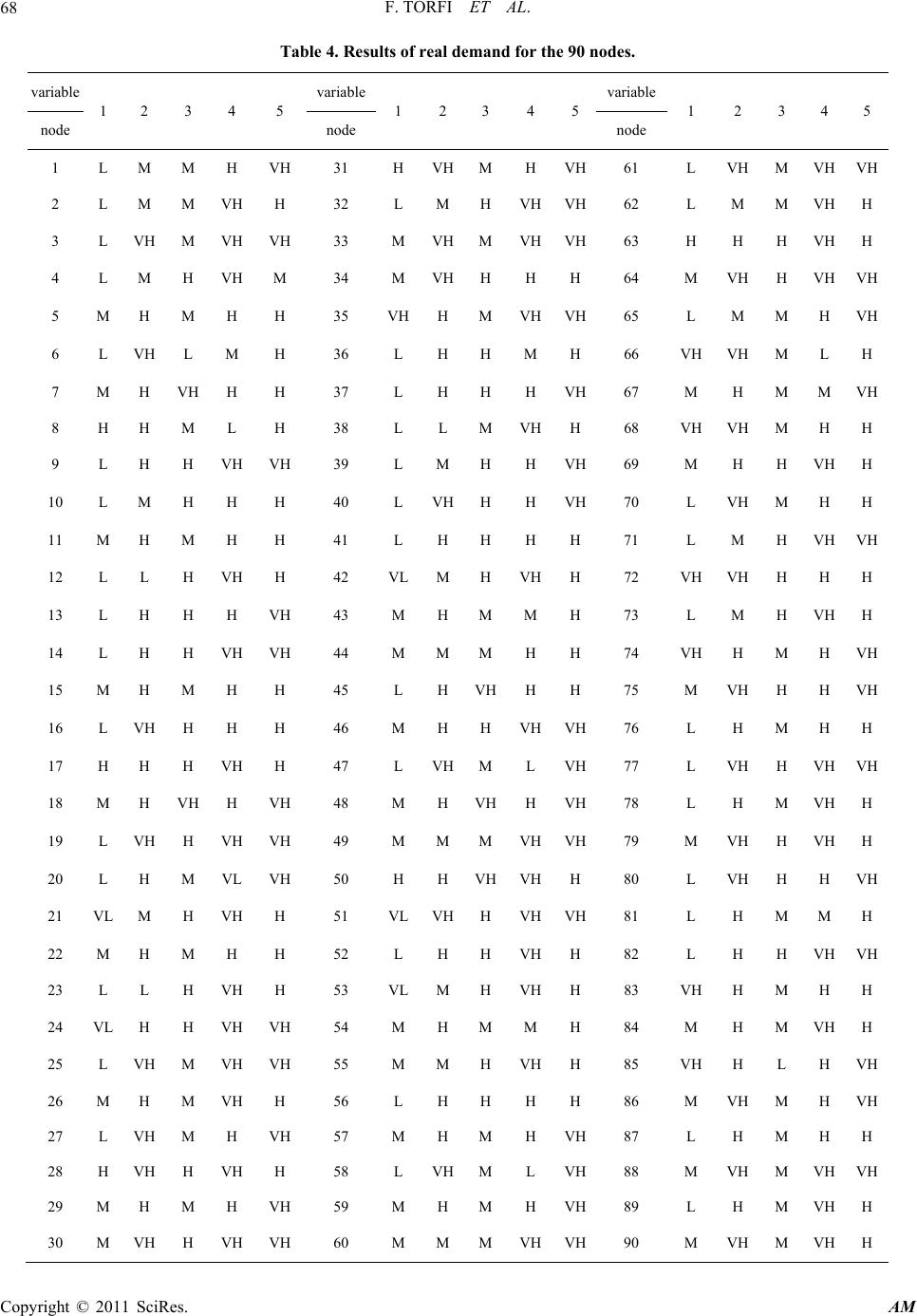 F. TORFI ET AL. Copyright © 2011 SciRes. AM 68 Table 4. Results of real demand for the 90 nodes. variable 1 2 3 4 5 variable 1 2 3 4 5 variable 1 2 3 4 5 node node node 1 L M M H VH 31 H VHMH VH61 L VH M VHVH 2 L M M VH H 32 L MH VHVH62 L M M VHH 3 L VH M VH VH 33 M VHMVHVH63 H H H VHH 4 L M H VH M 34 M VHH H H 64 M VH H VHVH 5 M H M H H 35 VHH MVHVH65 L M M H VH 6 L VH L MH 36 L H H M H 66 VH VH M L H 7 M H VH H H 37 L H H H VH67 M H M MVH 8 H H M L H 38 L L MVHH 68 VH VH M H H 9 L H H VH VH 39 L MH H VH69 M H H VHH 10 L M H H H 40 L VHH H VH70 L VH M H H 11 M H M H H 41 L H H H H 71 L M H VHVH 12 L L H VH H 42 VLMH VHH 72 VH VH H H H 13 L H H H VH 43 M H MM H 73 L M H VHH 14 L H H VH VH 44 M MMH H 74 VH H M H VH 15 M H M H H 45 L H VHH H 75 M VH H H VH 16 L VH H H H 46 M H H VHVH76 L H M H H 17 H H H VH H 47 L VHML VH77 L VH H VHVH 18 M H VH H VH 48 M H VHH VH78 L H M VHH 19 L VH H VH VH 49 M MMVHVH79 M VH H VHH 20 L H M VL VH 50 H H VHVHH 80 L VH H H VH 21 VL M H VH H 51 VLVHH VHVH81 L H M MH 22 M H M H H 52 L H H VHH 82 L H H VHVH 23 L L H VH H 53 VLMH VHH 83 VH H M H H 24 VL H H VH VH 54 M H MM H 84 M H M VHH 25 L VH M VH VH 55 M MH VHH 85 VH H L H VH 26 M H M VH H 56 L H H H H 86 M VH M H VH 27 L VH M H VH 57 M H MH VH87 L H M H H 28 H VH H VH H 58 L VHML VH88 M VH M VHVH 29 M H M H VH 59 M H MH VH89 L H M VHH 30 M VH H VH VH 60 M M MVHVH90 M VH M VHH  F. TORFI ET AL. Copyright © 2011 SciRes. AM 69 Table 5. Parameter estimates and SSR for model 1. No. Apprximate- distance (Y ) Nominal demand (ˆ Y) Real demand (Y) SSR based on Apprximate- distance 2, T dYY 2ˆ , T dYY y y y 0.00 0.10 0.25 H L 0.320156 0.692820 2 0.00 0.10 0.25 L L 0.320156 0 3 0.15 0.3 045 L M 0.346410 0.346410 4 0.00 0.10 0.25 L L 0.320156 0 5 0.00 0.10 0.25 L L 0.320156 0 6 0.35 0.5 0.65 L M 0 0.346410 7 0.00 0.10 0.25 L L 0.320156 0 8 0.00 0.10 0.25 L L 0.320156 0 9 0.35 0.5 0.65 L H 0.346410 0.692820 10 0.15 0.3 045 L L 0 0 11 0.00 0.10 0.25 L L 0.320156 0 12 0.15 0.3 045 L L 0 0 13 0.15 0.3 045 L M 0 0.346410 14 0.00 0.10 0.25 L L 0.320156 0 15 0.35 0.5 0.65 M H 0.346410 0.346410 16 0.00 0.10 0.25 L L 0.320156 0 17 0.00 0.10 0.25 M VL 0 0.665206 18 0.00 0.10 0.25 L L 0.320156 0 19 0.35 0.5 0.65 VH M 0 0.665206 20 0.15 0.3 045 L L 0 0 21 0.00 0.10 0.25 L L 0.320156 0 22 0.15 0.3 045 L L 0 0 23 0.35 0.5 0.65 H H 0.346410 0 24 0.00 0.10 0.25 L L 0.320156 0 25 0.35 0.5 0.65 VH H 0.346410 0.320156 26 0.15 0.3 045 L L 0 0 27 0.15 0.3 045 L L 0 0 28 0.00 0.10 0.25 VL L 0.346410 0.665206 29 0.00 0.10 0.25 L L 0.346410 0 30 0.15 0.3 045 VL M 0.665206 0.665206 31 0.35 0.5 0.65 L M 0 0.346410 32 0.00 0.10 0.25 VL L 0.320156 0.320156 33 0.35 0.5 0.65 M M 0 0 34 0.00 0.10 0.25 H M 0.136667 0.346410 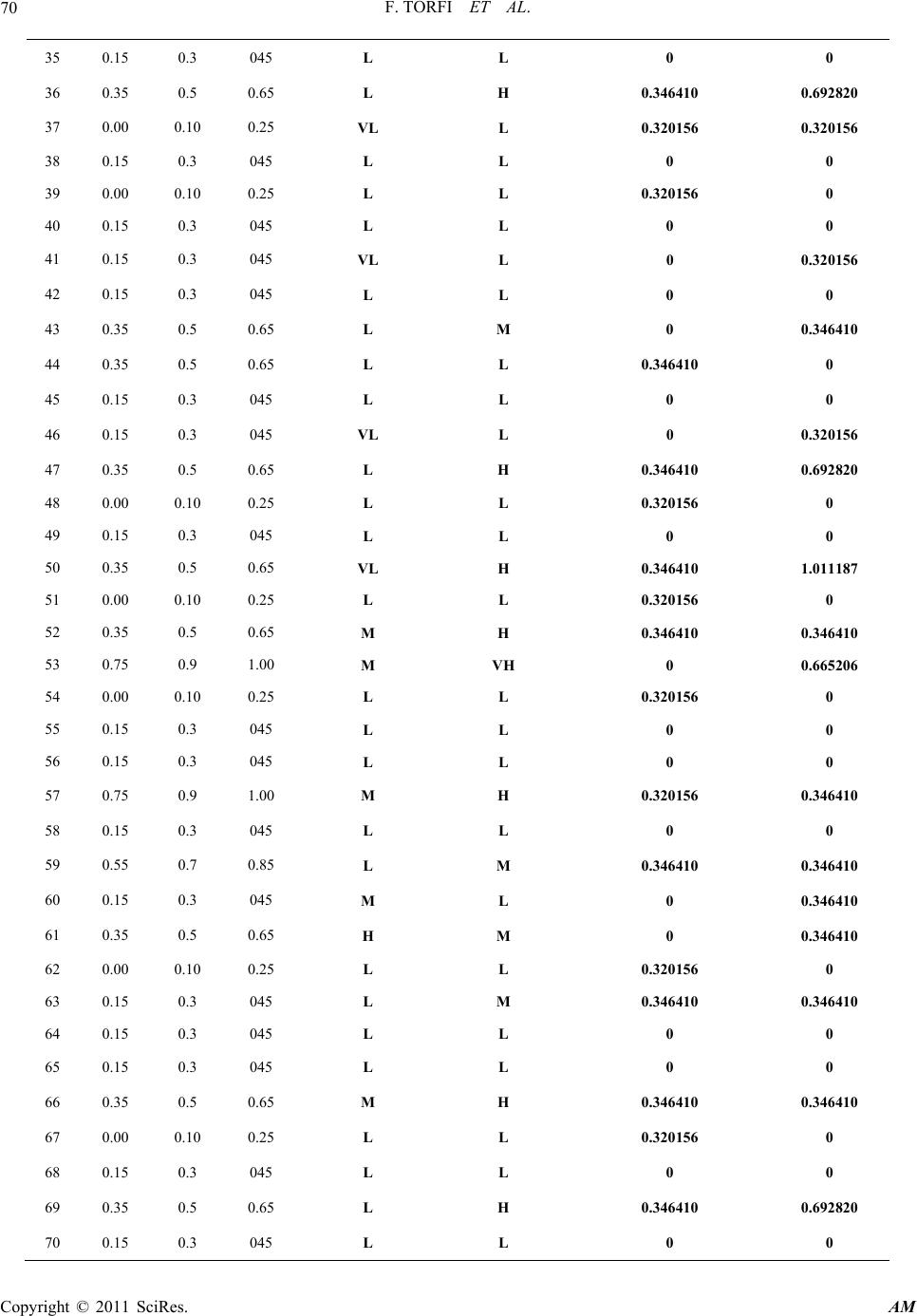 F. TORFI ET AL. Copyright © 2011 SciRes. AM 70 35 0.15 0.3 045 L L 0 0 36 0.35 0.5 0.65 L H 0.346410 0.692820 37 0.00 0.10 0.25 VL L 0.320156 0.320156 38 0.15 0.3 045 L L 0 0 39 0.00 0.10 0.25 L L 0.320156 0 40 0.15 0.3 045 L L 0 0 41 0.15 0.3 045 VL L 0 0.320156 42 0.15 0.3 045 L L 0 0 43 0.35 0.5 0.65 L M 0 0.346410 44 0.35 0.5 0.65 L L 0.346410 0 45 0.15 0.3 045 L L 0 0 46 0.15 0.3 045 VL L 0 0.320156 47 0.35 0.5 0.65 L H 0.346410 0.692820 48 0.00 0.10 0.25 L L 0.320156 0 49 0.15 0.3 045 L L 0 0 50 0.35 0.5 0.65 VL H 0.346410 1.011187 51 0.00 0.10 0.25 L L 0.320156 0 52 0.35 0.5 0.65 M H 0.346410 0.346410 53 0.75 0.9 1.00 M VH 0 0.665206 54 0.00 0.10 0.25 L L 0.320156 0 55 0.15 0.3 045 L L 0 0 56 0.15 0.3 045 L L 0 0 57 0.75 0.9 1.00 M H 0.320156 0.346410 58 0.15 0.3 045 L L 0 0 59 0.55 0.7 0.85 L M 0.346410 0.346410 60 0.15 0.3 045 M L 0 0.346410 61 0.35 0.5 0.65 H M 0 0.346410 62 0.00 0.10 0.25 L L 0.320156 0 63 0.15 0.3 045 L M 0.346410 0.346410 64 0.15 0.3 045 L L 0 0 65 0.15 0.3 045 L L 0 0 66 0.35 0.5 0.65 M H 0.346410 0.346410 67 0.00 0.10 0.25 L L 0.320156 0 68 0.15 0.3 045 L L 0 0 69 0.35 0.5 0.65 L H 0.346410 0.692820 70 0.15 0.3 045 L L 0 0 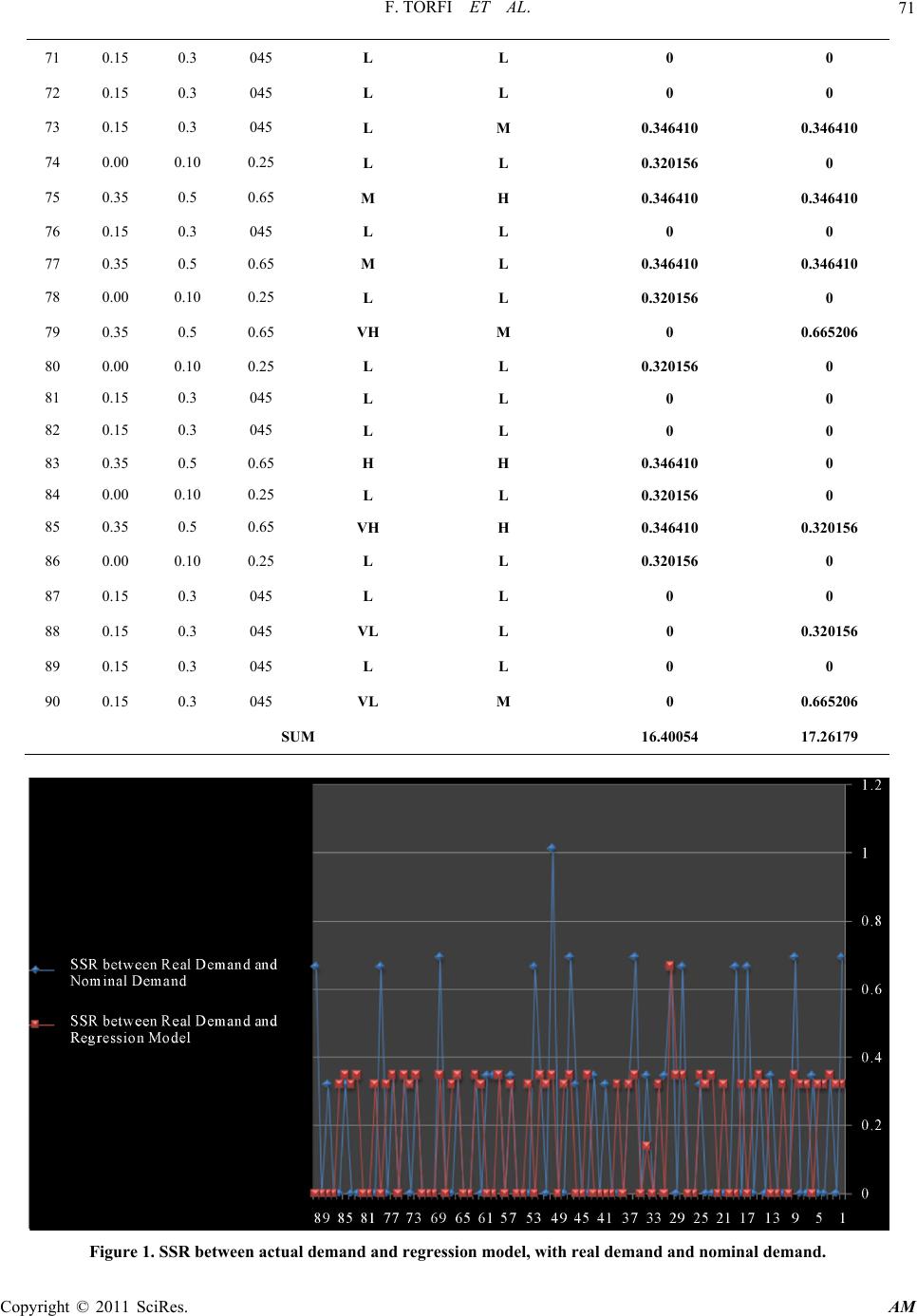 F. TORFI ET AL. Copyright © 2011 SciRes. AM 71 71 0.15 0.3 045 L L 0 0 72 0.15 0.3 045 L L 0 0 73 0.15 0.3 045 L M 0.346410 0.346410 74 0.00 0.10 0.25 L L 0.320156 0 75 0.35 0.5 0.65 M H 0.346410 0.346410 76 0.15 0.3 045 L L 0 0 77 0.35 0.5 0.65 M L 0.346410 0.346410 78 0.00 0.10 0.25 L L 0.320156 0 79 0.35 0.5 0.65 VH M 0 0.665206 80 0.00 0.10 0.25 L L 0.320156 0 81 0.15 0.3 045 L L 0 0 82 0.15 0.3 045 L L 0 0 83 0.35 0.5 0.65 H H 0.346410 0 84 0.00 0.10 0.25 L L 0.320156 0 85 0.35 0.5 0.65 VH H 0.346410 0.320156 86 0.00 0.10 0.25 L L 0.320156 0 87 0.15 0.3 045 L L 0 0 88 0.15 0.3 045 VL L 0 0.320156 89 0.15 0.3 045 L L 0 0 90 0.15 0.3 045 VL M 0 0.665206 SUM 16.40054 17.26179 Figure 1. SSR betwe en actual demand and regression model, with real demand and nominal de mand. 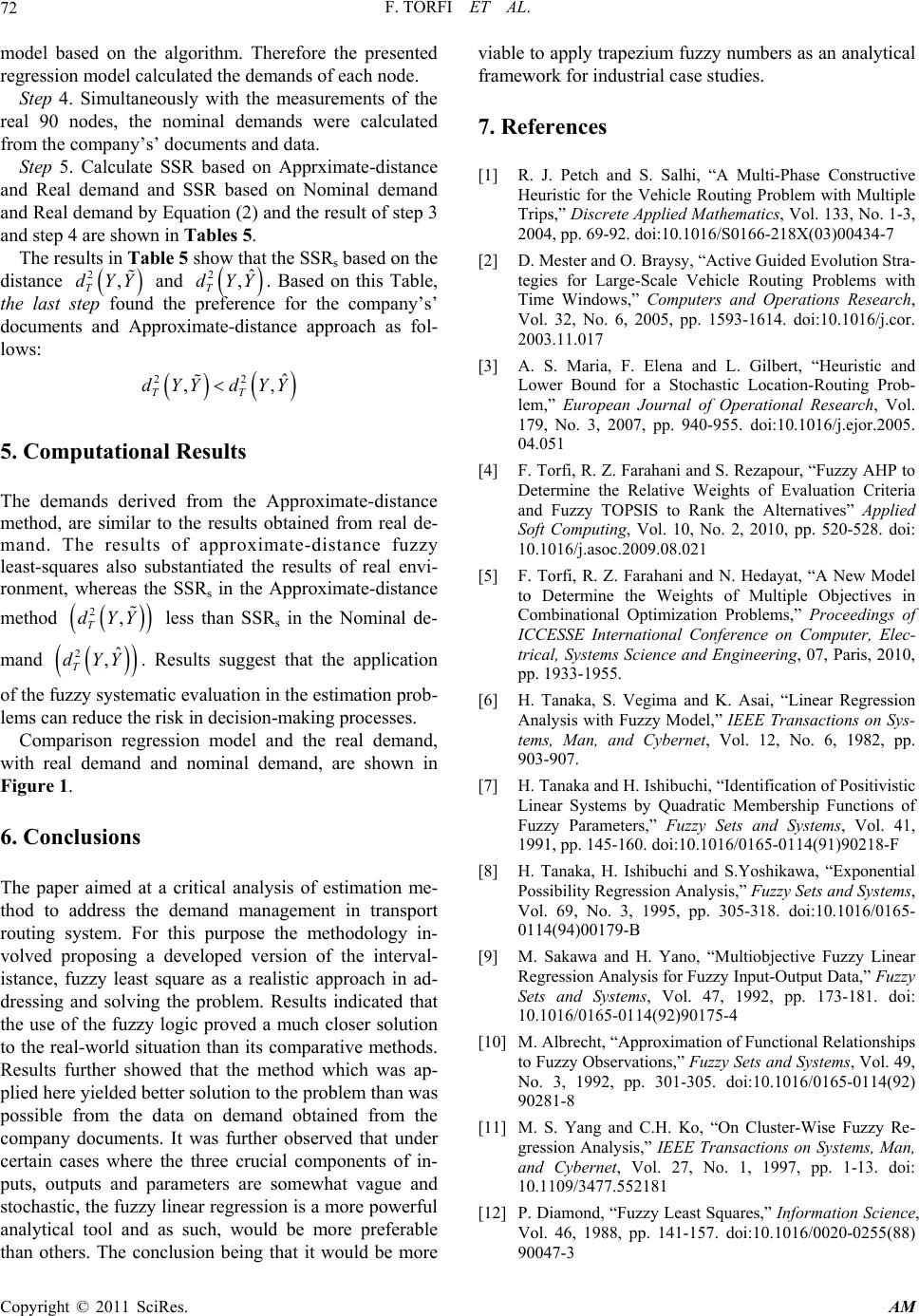 F. TORFI ET AL. Copyright © 2011 SciRes. AM 72 model based on the algorithm. Therefore the presented regression model calculated the demands of each node. Step 4. Simultaneously with the measurements of the real 90 nodes, the nominal demands were calculated from the company’s’ documents and data. Step 5. Calculate SSR based on Apprximate-distance and Real demand and SSR based on Nominal demand and Real demand by Equation (2) and the result of step 3 and step 4 are shown in Tables 5. The results in Table 5 show that the SSRs based on the distance 2, T dYY and 2ˆ , T dYY. Based on this Table, the last step found the preference for the company’s’ documents and Approximate-distance approach as fol- lows: 22 ˆ ,, TT dYY dYY 5. Computational Results The demands derived from the Approximate-distance method, are similar to the results obtained from real de- mand. The results of approximate-distance fuzzy least-squares also substantiated the results of real envi- ronment, whereas the SSRs in the Approximate-distance method 2, T dYY less than SSRs in the Nominal de- mand 2ˆ , T dYY. Results suggest that the application of the fuzzy systematic evaluation in the estimation prob- lems can reduce the risk in decision-making processes. Comparison regression model and the real demand, with real demand and nominal demand, are shown in Figure 1. 6. Conclusions The paper aimed at a critical analysis of estimation me- thod to address the demand management in transport routing system. For this purpose the methodology in- volved proposing a developed version of the interval- istance, fuzzy least square as a realistic approach in ad- dressing and solving the problem. Results indicated that the use of the fuzzy logic proved a much closer solution to the real-world situation than its comparative methods. Results further showed that the method which was ap- plied here yielded better solution to the problem than was possible from the data on demand obtained from the company documents. It was further observed that under certain cases where the three crucial components of in- puts, outputs and parameters are somewhat vague and stochastic, the fuzzy linear regression is a more powerful analytical tool and as such, would be more preferable than others. The conclusion being that it would be more viable to apply trapezium fuzzy numbers as an analytical framework for industrial case studies. 7. References [1] R. J. Petch and S. Salhi, “A Multi-Phase Constructive Heuristic for the Vehicle Routing Problem with Multiple Trips,” Discrete Applied Mathematics, Vol. 133, No. 1-3, 2004, pp. 69-92. doi:10.1016/S0166-218X(03)00434-7 [2] D. Mester and O. Braysy, “Active Guided Evolution Stra- tegies for Large-Scale Vehicle Routing Problems with Time Windows,” Computers and Operations Research, Vol. 32, No. 6, 2005, pp. 1593-1614. doi:10.1016/j.cor. 2003.11.017 [3] A. S. Maria, F. Elena and L. Gilbert, “Heuristic and Lower Bound for a Stochastic Location-Routing Prob- lem,” European Journal of Operational Research, Vol. 179, No. 3, 2007, pp. 940-955. doi:10.1016/j.ejor.2005. 04.051 [4] F. Torfi, R. Z. Farahani and S. Rezapour, “Fuzzy AHP to Determine the Relative Weights of Evaluation Criteria and Fuzzy TOPSIS to Rank the Alternatives” Applied Soft Computing, Vol. 10, No. 2, 2010, pp. 520-528. doi: 10.1016/j.asoc.2009.08.021 [5] F. Torfi, R. Z. Farahani and N. Hedayat, “A New Model to Determine the Weights of Multiple Objectives in Combinational Optimization Problems,” Proceedings of ICCESSE International Conference on Computer, Elec- trical, Systems Science and Engineering, 07, Paris, 2010, pp. 1933-1955. [6] H. Tanaka, S. Vegima and K. Asai, “Linear Regression Analysis with Fuzzy Model,” IEEE Transactions on Sys- tems, Man, and Cybernet, Vol. 12, No. 6, 1982, pp. 903-907. [7] H. Tanaka and H. Ishibuchi, “Identification of Positivistic Linear Systems by Quadratic Membership Functions of Fuzzy Parameters,” Fuzzy Sets and Systems, Vol. 41, 1991, pp. 145-160. doi:10.1016/0165-0114(91)90218-F [8] H. Tanaka, H. Ishibuchi and S.Yoshikawa, “Exponential Possibility Regression Analysis,” Fuzzy Sets and Systems, Vol. 69, No. 3, 1995, pp. 305-318. doi:10.1016/0165- 0114(94)00179-B [9] M. Sakawa and H. Yano, “Multiobjective Fuzzy Linear Regression Analysis for Fuzzy Input-Output Data,” Fuzzy Sets and Systems, Vol. 47, 1992, pp. 173-181. doi: 10.1016/0165-0114(92)90175-4 [10] M. Albrecht, “Approximation of Functional Relationships to Fuzzy Observations,” Fuzzy Sets and Systems, Vol. 49, No. 3, 1992, pp. 301-305. doi:10.1016/0165-0114(92) 90281-8 [11] M. S. Yang and C.H. Ko, “On Cluster-Wise Fuzzy Re- gression Analysis,” IEEE Transactions on Systems, Man, and Cybernet, Vol. 27, No. 1, 1997, pp. 1-13. doi: 10.1109/3477.552181 [12] P. Diamond, “Fuzzy Least Squares,” Information Science, Vol. 46, 1988, pp. 141-157. doi:10.1016/0020-0255(88) 90047-3 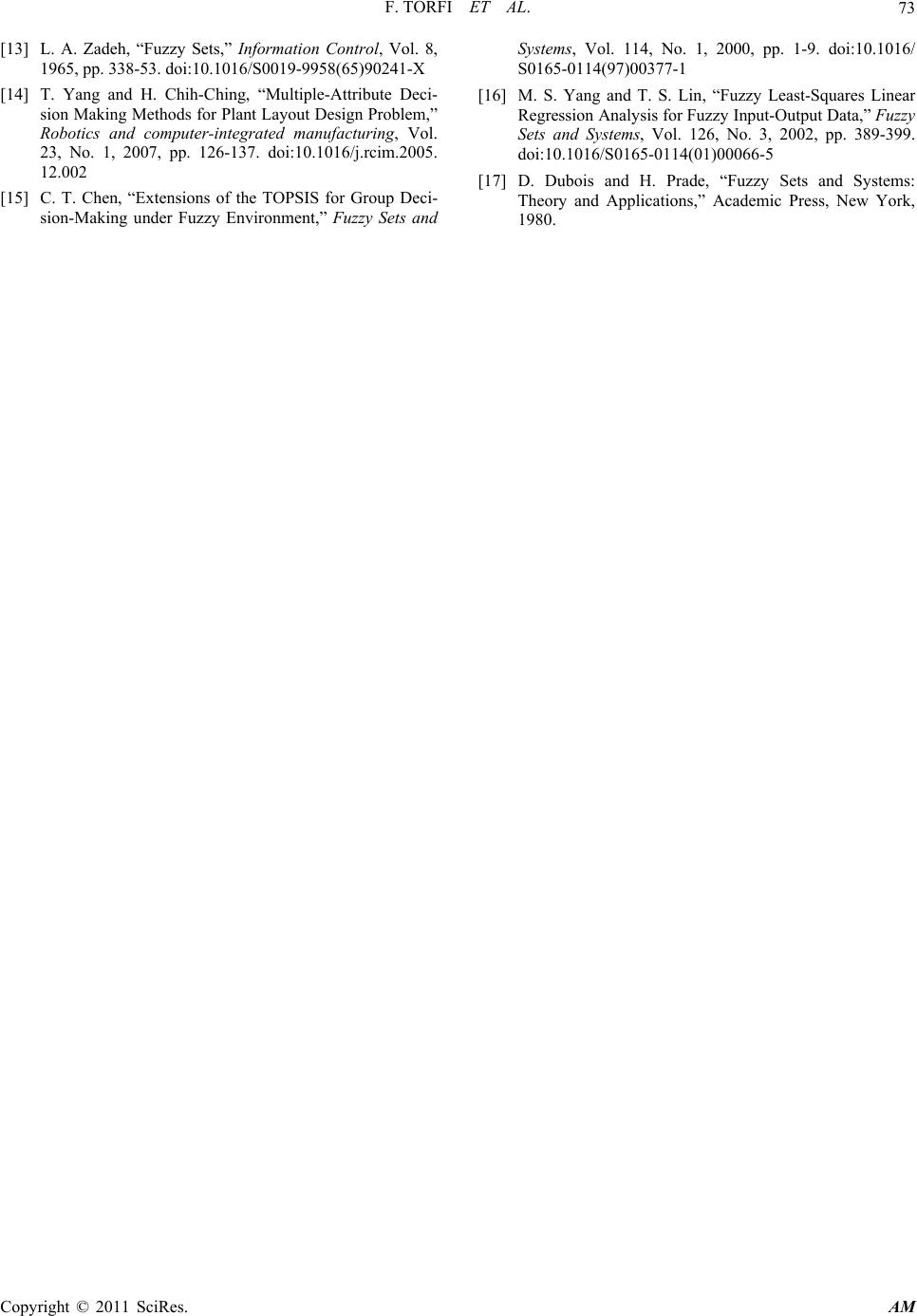 F. TORFI ET AL. Copyright © 2011 SciRes. AM 73 [13] L. A. Zadeh, “Fuzzy Sets,” Information Control, Vol. 8, 1965, pp. 338-53. doi:10.1016/S0019-9958(65)90241-X [14] T. Yang and H. Chih-Ching, “Multiple-Attribute Deci- sion Making Methods for Plant Layout Design Problem,” Robotics and computer-integrated manufacturing, Vol. 23, No. 1, 2007, pp. 126-137. doi:10.1016/j.rcim.2005. 12.002 [15] C. T. Chen, “Extensions of the TOPSIS for Group Deci- sion-Making under Fuzzy Environment,” Fuzzy Sets and Systems, Vol. 114, No. 1, 2000, pp. 1-9. doi:10.1016/ S0165-0114(97)00377-1 [16] M. S. Yang and T. S. Lin, “Fuzzy Least-Squares Linear Regression Analysis for Fuzzy Input-Output Data,” Fuzzy Sets and Systems, Vol. 126, No. 3, 2002, pp. 389-399. doi:10.1016/S0165-0114(01)00066-5 [17] D. Dubois and H. Prade, “Fuzzy Sets and Systems: Theory and Applications,” Academic Press, New York, 1980. |

